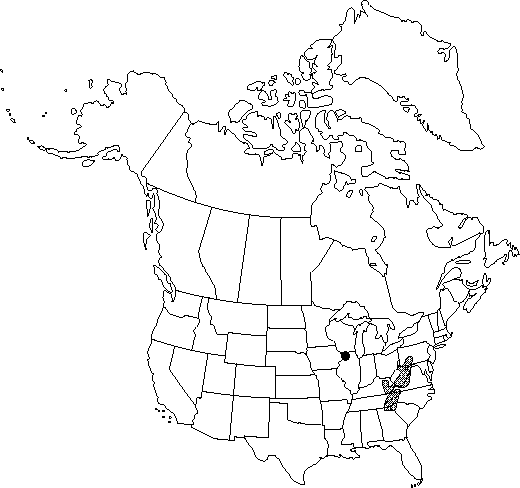Difference between revisions of "Cimicifuga americana"
Fl. Bor.-Amer. 1: 316. 1803.
FNA>Volume Importer |
FNA>Volume Importer |
||
| Line 19: | Line 19: | ||
|name=Cimicifuga cordifolia | |name=Cimicifuga cordifolia | ||
|authority=Pursh | |authority=Pursh | ||
| − | }}{{Treatment/ID/Synonym | + | }} {{Treatment/ID/Synonym |
|name=Cimicifuga racemosa var. cordifolia | |name=Cimicifuga racemosa var. cordifolia | ||
|authority=(Pursh) A. Gray | |authority=(Pursh) A. Gray | ||
| Line 37: | Line 37: | ||
|elevation=300-2000 m | |elevation=300-2000 m | ||
|distribution=Ga.;Ill.;Ky.;Md.;N.C.;Pa.;S.C.;Tenn.;Va.;W.Va. | |distribution=Ga.;Ill.;Ky.;Md.;N.C.;Pa.;S.C.;Tenn.;Va.;W.Va. | ||
| − | |discussion=<p>Much confusion has developed over the name Cimicifuga cordifolia Pursh. Although F. Pursh (1814, vol. 2, pp. 372-373) considered it synonymous with C. americana, several other authors have variously misapplied the name C. cordifolia to C. racemosa and C. rubifolia.</p> | + | |discussion=<p>Much confusion has developed over the name <i>Cimicifuga</i> cordifolia Pursh. Although F. Pursh (1814, vol. 2, pp. 372-373) considered it synonymous with <i>C. americana</i>, several other authors have variously misapplied the name <i>C. cordifolia</i> to <i>C. racemosa</i> and <i>C. rubifolia</i>.</p> |
|tables= | |tables= | ||
|references= | |references= | ||
| Line 61: | Line 61: | ||
|publication year=1803 | |publication year=1803 | ||
|special status=Endemic;Selected by author to be illustrated | |special status=Endemic;Selected by author to be illustrated | ||
| − | |source xml=https://jpend@bitbucket.org/aafc-mbb/fna-data-curation.git/src/ | + | |source xml=https://jpend@bitbucket.org/aafc-mbb/fna-data-curation.git/src/8f726806613d60c220dc4493de13607dd3150896/coarse_grained_fna_xml/V3/V3_1126.xml |
|genus=Cimicifuga | |genus=Cimicifuga | ||
|species=Cimicifuga americana | |species=Cimicifuga americana | ||
Revision as of 17:14, 18 September 2019
Stems 60-250 cm, usually glabrous, rarely sparsely pubescent. Leaves: petiole rounded abaxially, 8-16 cm, broadly and shallowly grooved adaxially, glabrous, rarely with a few lax hairs in groove. Leaf blade (2-)3-ternately compound; leaflets 32-100; terminal leaflet of central segment ovate to oblong, incisely 3-lobed, 6-15 × 4-14 cm, with 3 veins arising basally, base cuneate to somewhat cordate, margins dentate to serrate, apex acute to acuminate, surfaces glabrous or glabrate; other leaflets 3-15 × 3-10 cm. Inflorescences ± lax panicles of 3-10 racemelike branches, 10-50 cm, densely short-pubescent and granular; bract 1, subtending pedicel, broadly triangular, acute, 1-3 mm; pedicel to 20 mm, granular, bracteoles present along most of pedicel, narrowly triangular, acute. Flowers: sepals 5, 3 outer white tinged red, 2 inner yellowish green; petals usually 2, rarely more, sessile, body yellowish with white lobes, ovate, 3-6 mm; nectary basal; stamens 40-70; filaments 6-10 mm; pistils 3-8, short-stipitate, body glabrous, stipe granular; style subulate, often curved; stigma minute, 0.2 mm wide. Follicles 2-4, stipitate, obovate, laterally compressed, 8-17 mm, membranous walled, glabrous. Seeds pale brown, lenticular, ca. 3.5 mm, covered with whitish, broad, lacerate scales but not apprearing cylindric.
Phenology: Flowering summer–fall (Aug–Oct).
Habitat: Moist, rich, rocky and boulder-strewn, wooded slopes and coves
Elevation: 300-2000 m
Distribution

Ga., Ill., Ky., Md., N.C., Pa., S.C., Tenn., Va., W.Va.
Discussion
Much confusion has developed over the name Cimicifuga cordifolia Pursh. Although F. Pursh (1814, vol. 2, pp. 372-373) considered it synonymous with C. americana, several other authors have variously misapplied the name C. cordifolia to C. racemosa and C. rubifolia.
Selected References
None.
